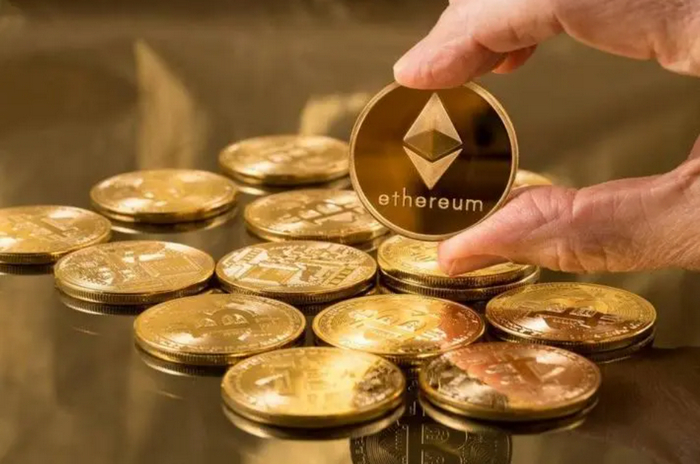What is Ethereum cross-chain bridge? How to achieve asset transfer?
Jul 02, 2025 pm 10:57 PMBlockchain technology has spawned many independent networks, such as Ethereum, Binance Smart Chain, Polygon, etc. Each network has its own unique design and protocol. However, this independence also presents the challenge of difficult assets and information flowing freely between different chains. For example, ERC-20 tokens on Ethereum cannot be used directly on the Polygon network. In order to solve this isolation problem, cross-chain bridges emerged and became the key infrastructure to connect different blockchain networks.
What is a cross-chain bridge?
1. A cross-chain bridge is a tool or protocol that allows assets, data or information to be transferred between different blockchain networks.
2. They are essentially connectors between different chains, allowing users to send digital assets from one chain to another without leaving the blockchain ecosystem.
3. The Ethereum cross-chain bridge specifically refers to the bridge connecting Ethereum with other chains (such as the Layer 2 network or the independent Layer 1 network).

Overview of the working principle of cross-chain bridge
1. Most asset cross-chain bridges use the "lock-casting" or "destruction-casting" mechanism to achieve asset transfer.
2. When the user wants to transfer assets from Chain A to Chain B, the original assets on Chain A will be locked in a smart contract.
3. At the same time, on Chain B, an equal amount of "mapping tokens" or "encapsulated tokens" (such as WETH or WBNB) of the asset will be minted (issued) based on the number of assets locked on Chain A.
4. When the user wants to transfer assets from chain B to chain A, the mapping tokens on chain B will be destroyed, and the corresponding number of original assets on chain A will be unlocked and returned to the user.
Process of transferring assets through cross-chain bridge
1. The user selects the assets and target chains to be transferred and initiates a transfer request on the application interface of the cross-chain bridge.
2. The user approves the transaction and sends the assets to the cross-chain bridge to lock in the smart contract on the source chain.
3. Events on the source chain (assets have been locked) will be monitored by network participants such as Relayers, Validators, or Oracles.
4. This information is then safely transmitted to the target chain.
5. After the smart contract on the target chain verifys the validity of the information received, it will mint or release the corresponding number of mapped assets for the user at the address of the target chain.
6. Users can use these cross-chain assets on the target chain.

Several common types of cross-chain bridges
1. Centralized bridges rely on one or a few trusted third parties to keep assets and verify transactions. This method is simple and fast, but there are single-point risk and trust problems.
2. Alliance-style bridges are jointly managed and verified by a group of pre-determined validators or multiple signature parties. It is more decentralized than centralized bridges, but it still requires trust in most validators.
3. Decentralized/trustless bridges are designed to eliminate or minimize trust in third parties through cryptographic proofs, incentive mechanisms, or license-free verification networks. This type of bridge is complex in design but provides greater security and no trust.
The above is the detailed content of What is Ethereum cross-chain bridge? How to achieve asset transfer?. For more information, please follow other related articles on the PHP Chinese website!

Hot AI Tools

Undress AI Tool
Undress images for free

Undresser.AI Undress
AI-powered app for creating realistic nude photos

AI Clothes Remover
Online AI tool for removing clothes from photos.

Clothoff.io
AI clothes remover

Video Face Swap
Swap faces in any video effortlessly with our completely free AI face swap tool!

Hot Article

Hot Tools

Notepad++7.3.1
Easy-to-use and free code editor

SublimeText3 Chinese version
Chinese version, very easy to use

Zend Studio 13.0.1
Powerful PHP integrated development environment

Dreamweaver CS6
Visual web development tools

SublimeText3 Mac version
God-level code editing software (SublimeText3)

Hot Topics
 How to get stablecoin USDT for free_Xiaobai stablecoin USDT obtain guide
Jul 15, 2025 pm 11:51 PM
How to get stablecoin USDT for free_Xiaobai stablecoin USDT obtain guide
Jul 15, 2025 pm 11:51 PM
Yes, you can get USDT for free in the following 5 ways: 1. Participate in airdrop tasks on mainstream exchanges, such as registering and giving away, completing novice tasks, and inviting friends to get rewards; 2. Join the blockchain project community and obtain airdrops through Web3 social platform or Twitter/Discord interaction; 3. Participate in the "test network" activity, register the test chain address and simulate the use of DApp to get incentives; 4. Complete tasks on the cryptocurrency navigation platform to receive novice gift packages, participate in sign-in, lottery and other activities; 5. Interact with the content creation and community, and publish original content to obtain USDT rewards from the project party. At the same time, you need to pay attention to security risks, do not fill in private keys, do not believe in scams, and choose mainstream platforms to participate.
 LayerZero, StarkNet, ZK Ecological Preheat: How long can the airdrop bonus last?
Jul 16, 2025 am 10:06 AM
LayerZero, StarkNet, ZK Ecological Preheat: How long can the airdrop bonus last?
Jul 16, 2025 am 10:06 AM
The duration of the airdrop dividend is uncertain, but the LayerZero, StarkNet and ZK ecosystems still have long-term value. 1. LayerZero achieves cross-chain interoperability through lightweight protocols; 2. StarkNet provides efficient and low-cost Ethereum L2 expansion solutions based on ZK-STARKs technology; 3. ZK ecosystem (such as zkSync, Scroll, etc.) expands the application of zero-knowledge proof in scaling and privacy protection; 4. Participation methods include the use of bridging tools, interactive DApps, participating test networks, pledged assets, etc., aiming to experience the next generation of blockchain infrastructure in advance and strive for potential airdrop opportunities.
 Is the stablecoin USDT a scam? Is the company behind the stablecoin USDT reliable?
Jul 15, 2025 pm 11:57 PM
Is the stablecoin USDT a scam? Is the company behind the stablecoin USDT reliable?
Jul 15, 2025 pm 11:57 PM
USDT is not a scam, but there are risks. 1. Tether provides liquidity in the crypto market by issuing USDT, a stablecoin anchored by the US dollar; 2. The company's background is related to Bitfinex, and has been fined for audit issues but has increased transparency; 3. The reserve assets are mainly US Treasury bonds rather than pure cash, and there are certain financial risks; 4. Face risks such as insufficient audit frequency, centralized control and compliance restrictions; 5. The USDT market is highly accepted, but trust needs to be based on continuous disclosure and compliance operations. Overall, USDT is trustworthy but does not equal zero risk, and users should be cautious.
 Which is better, DAI or USDC?_Is DAI suitable for long-term holding?
Jul 15, 2025 pm 11:18 PM
Which is better, DAI or USDC?_Is DAI suitable for long-term holding?
Jul 15, 2025 pm 11:18 PM
Is DAI suitable for long-term holding? The answer depends on individual needs and risk preferences. 1. DAI is a decentralized stablecoin, generated by excessive collateral for crypto assets, suitable for users who pursue censorship resistance and transparency; 2. Its stability is slightly inferior to USDC, and may experience slight deansal due to collateral fluctuations; 3. Applicable to lending, pledge and governance scenarios in the DeFi ecosystem; 4. Pay attention to the upgrade and governance risks of MakerDAO system. If you pursue high stability and compliance guarantees, it is recommended to choose USDC; if you attach importance to the concept of decentralization and actively participate in DeFi applications, DAI has long-term value. The combination of the two can also improve the security and flexibility of asset allocation.
 How to transfer USDT to the exchange of stablecoin_Detailed explanation of USDT exchange trading operations
Jul 15, 2025 pm 11:36 PM
How to transfer USDT to the exchange of stablecoin_Detailed explanation of USDT exchange trading operations
Jul 15, 2025 pm 11:36 PM
To transfer USDT to the exchange for transactions, you must first confirm that the chain type matches, the address is correct, and complete real-name authentication. 1. Register and authenticate the mainstream exchange account with real name; 2. Confirm that the wallet is consistent with the USDT chain type of the exchange (such as TRC20); 3. Obtain the recharge address of the corresponding chain on the exchange and copy it accurately; 4. Initiate transfers from the wallet and pay the corresponding handling fee; 5. After arrival, you can trade in the spot or contract market; 6. Pay attention to checking the address, avoid transferring to the contract address, and give priority to low-processing networks. The entire process is usually completed in minutes, ensuring operational safety is key.
 Who is suitable for stablecoin DAI_ Analysis of decentralized stablecoin usage scenarios
Jul 15, 2025 pm 11:27 PM
Who is suitable for stablecoin DAI_ Analysis of decentralized stablecoin usage scenarios
Jul 15, 2025 pm 11:27 PM
DAI is suitable for users who attach importance to the concept of decentralization, actively participate in the DeFi ecosystem, need cross-chain asset liquidity, and pursue asset transparency and autonomy. 1. Supporters of the decentralization concept trust smart contracts and community governance; 2. DeFi users can be used for lending, pledge, and liquidity mining; 3. Cross-chain users can achieve flexible transfer of multi-chain assets; 4. Governance participants can influence system decisions through voting. Its main scenarios include decentralized lending, asset hedging, liquidity mining, cross-border payments and community governance. At the same time, it is necessary to pay attention to system risks, mortgage fluctuations risks and technical threshold issues.
 Is USDC safe? What is the difference between USDC and USDT
Jul 15, 2025 pm 11:48 PM
Is USDC safe? What is the difference between USDC and USDT
Jul 15, 2025 pm 11:48 PM
USDC is safe. It is jointly issued by Circle and Coinbase. It is regulated by the US FinCEN. Its reserve assets are US dollar cash and US bonds. It is regularly audited independently, with high transparency. 1. USDC has strong compliance and is strictly regulated by the United States; 2. The reserve asset structure is clear, supported by cash and Treasury bonds; 3. The audit frequency is high and transparent; 4. It is widely accepted by institutions in many countries and is suitable for scenarios such as DeFi and compliant payments. In comparison, USDT is issued by Tether, with an offshore registration location, insufficient early disclosure, and reserves with low liquidity assets such as commercial paper. Although the circulation volume is large, the regulatory recognition is slightly low, and it is suitable for users who pay attention to liquidity. Both have their own advantages, and the choice should be determined based on the purpose and preferences of use.
 How to exchange USDT for stablecoin USDT into cash_USDT withdrawal tutorial
Jul 15, 2025 pm 11:54 PM
How to exchange USDT for stablecoin USDT into cash_USDT withdrawal tutorial
Jul 15, 2025 pm 11:54 PM
USDT cash exchange needs to be operated through a trading platform that supports fiat currency withdrawal. 1. Prepare a trading platform account that supports fiat currency withdrawal (such as Binance, Ouyi, Huobi, etc.); 2. Complete KYC real-name authentication; 3. Bind bank cards or Alipay and other payment methods; 4. Log in to the account and ensure that USDT is in the fund account or spot account; 5. Enter the OTC or fiat currency area and choose to sell USDT; 6. Set the sales amount and match the buyer; 7. After confirming the other party’s payment, click “Confirm Coin Delivery” to complete the transaction. Withdrawal methods include OTC fiat currency transactions, bank card withdrawals and third-party payments, among which OTC is more efficient. Notes include making sure to verify that the money is received before releasing, avoiding frequent large withdrawals, and contacting customer service in time when encountering abnormalities. The key to the entire process is to choose





